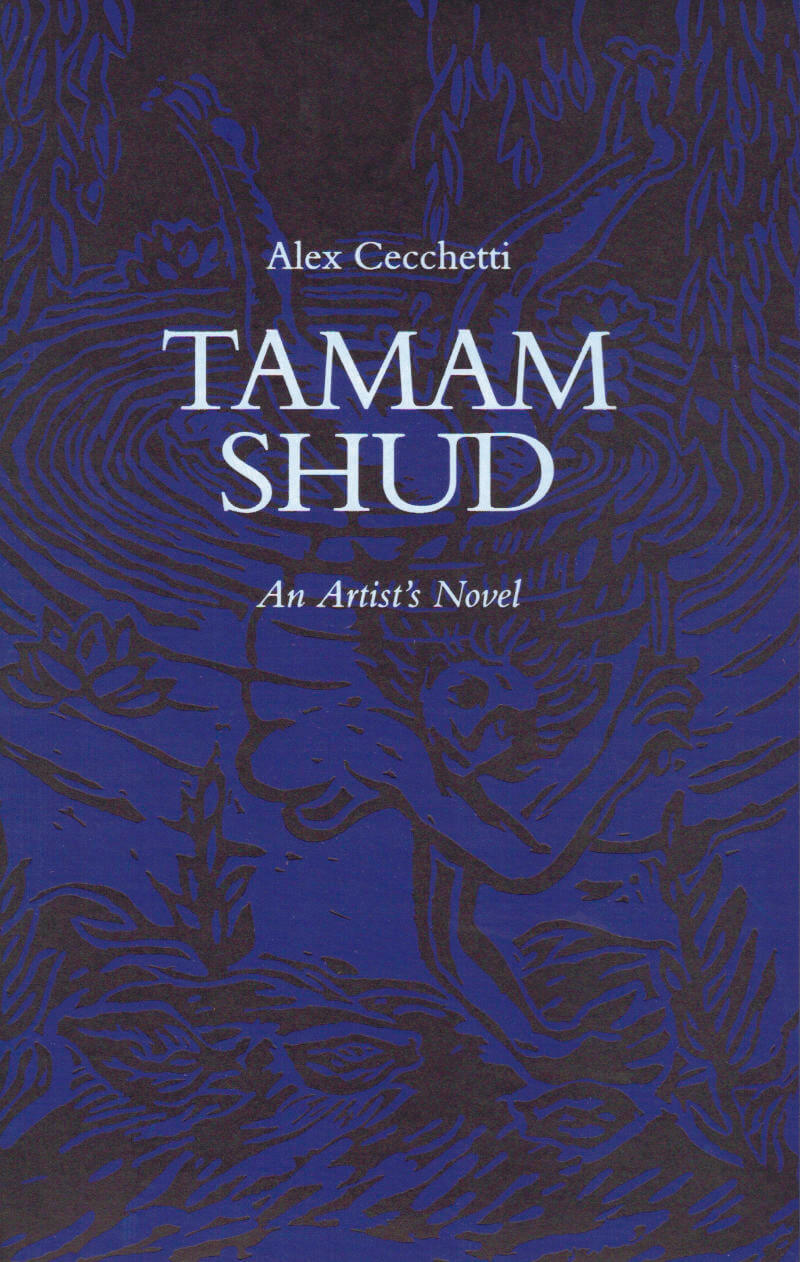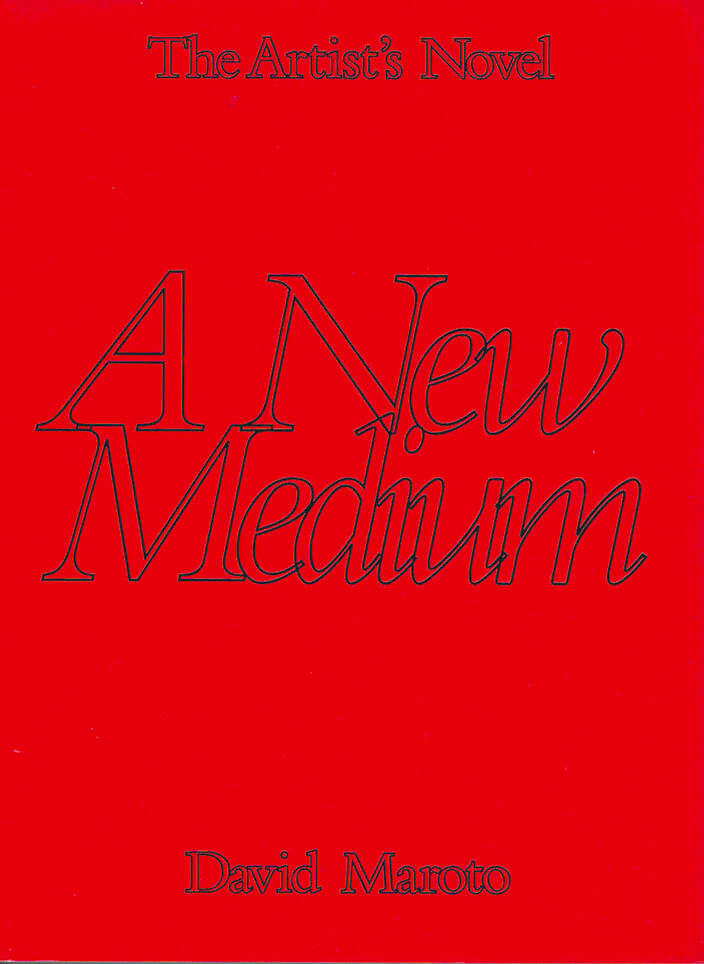Alex Cecchetti
Alex Cecchetti

Tamam Shud
A mystery murder artist's novel by Alex Cecchetti, in which the artist and narrator realises he is dead and decides to investigate the causes of his own death.
“I am dead. Homicide, assassination, accident, suicide, the detectives have come up with nothing. The labels in my clothes, my fingerprints, my shoe size, everything has been unstitched, erased, wiped away, blanched, bleached, and consigned to oblivion. As the only clue, in a secret pocket sewn into my trousers, the detectives found a flimsy slip of paper torn from the pages of a book. On that folded bit of paper just two words, Tamam Shud, “this is the end.” Experts, antiquarians, and opium smokers have been consulted, and all agree that these are the last two words in the Rubaiyat, an ancient collection of esoteric poems written by a Persian poet named Omar Khayyam. What the hell do I have to do with poetry, Persia, and hidden pockets? I can't even sew on a button. My identity is still unknown and not even I remember much. This is why I have decided to investigate my own death.”
The Tamam Shud narrative emerged through a series of episodic performances and an exhibition by Alex Cecchetti at the Ujazdowski Castle Centre for Contemporary Art, Warsaw. For two years the writing process and the artistic process were interwoven, feeding each other as they evolved. The art project and the artist's novel are linked together as much as the life of the victim is connected to the piece of paper found in his pocket.
Artist, poet and choreographer, creator of performances and idiosyncratic objects, Alex Cecchetti (born 1977 in Terni, Italy, lives and works in Paris) has developed a unique practice, difficult to classify, that could be called art of avoidance: tactical and poetic, aesthetic and materialistic, its system leads to produce specific situations or objects that can exist both inside and outside the traditional exhibitions. It is in this double movement of representation and conceal that it's possible to inscribe his staging of invisible choreographies of hidden nudes and sleeping dancers. His work is focused in the construction of specific narratives that are experienced both mentally and physically by the audience.
And more

Dance First Think Later
An encounter between dance and visual arts.
Dance First Think Later - The Thinking Body between Dance and Visual Arts follows on from the exhibition-festival Dance First Think Later - An Encounter between Dance and Visual Arts, presented in Geneva in summer 2020, documenting it with a wealth of iconography and enriching it with a critical, theoretical and historical perspective on the works and the project. Commissioned texts are devoted to the 22 artists, written by authors active in museums, festivals, art schools, independent critics and artists.
The biennial event Dance First Think Later explores the converging fields between dance, performance, visual arts and moving images. Arta Sperto, which is organising and producing the exhibition-festival and publishing the book, is developing a cross-disciplinary approach that combines the operating mechanisms of the visual and performing arts, and the respective characteristics of museums/art centres and theatres/festivals. This approach is motivated by the need to support artists whose cross-disciplinary practices come up against the way in which culture is still largely organised by field, whether in terms of cultural policies, institutions, funding or the media. Starting with the works themselves, the book offers food for thought on cross-disciplinary approaches to the contemporary arts.
With / around Halil Altindere, Alexandra Bachzetsis & Julia Born, Pauline Boudry & Renate Lorenz, Alex Cecchetti, Clément Cogitore, Dara Friedman, Gerard & Kelly, Marie-Caroline Hominal, Lenio Kaklea, La Ribot, Pierre Leguillon, Xavier Le Roy, Klara Lidén, Melanie Manchot, Olivier Mosset & Jacob Kassay, Samuel Pajand, Christodoulos Panayiotou, Alexandra Pirici, Julien Prévieux, Marinella Senatore, Gregory Stauffer, Barbara Wagner & Benjamin de Burca.

A New Medium
The first of a two-volume publication dedicated to the artist's novel, this theoretical essay aims to elucidate the pressing questions posed by the emergence of this new artistic medium with a number of key case studies and interviews.
Why do artists write novels? What impact does the artist's novel have on the visual arts? How should such a novel be experienced? In recent years, there has been a proliferation of visual artists who create novels as part of their broader art practice. They do so in order to address artistic issues by means of novelistic devices, favoring a sort of art predicated on process and subjectivity, introducing notions such as fiction, narrative, and imagination. In this sense, it is possible to see the novel as a new medium in the visual arts; yet very little is known about it. This two-volume publication is the first to explore in depth the subject of the artist's novel.
Part 1, A New Medium, is a theoretical examination that looks critically at the different ways contemporary artists employ the artist's novel, focusing mainly on four key case studies: Benjamin Seror's Mime Radio, Cally Spooner's Collapsing in Parts, Mai-Thu Perret's The Crystal Frontier, and Goldin+Senneby's Headless. It seeks to situate the artist's novel within the broader context of the visual arts in the hopes of sparking a much-needed discussion about a practice that has long been ignored by critical strands in art discourse. It includes valuable resources, such as the only existing bibliography of artists' novels.
Interviews with Benjamin Seror, Cally Spooner, Mai-Thu Perret, Goldin+Senneby, Francis McKee, Vivian Ziherl, Natasha Soobramanien, Clive Phillpot, Alex Cecchetti, Łukasz Gorczyca, Jan Jasiński.

MAL, Nº 3: PLANTSEX
Kathryn Maris, Maria Dimitrova
On botany and eroticism in twelve essays, stories and poems. Published in collaboration with Serpentine Galleries.
First published: April 2019.
This issue of Mal Journal features an essay by Chloe Aridjis on Mexican flora and its foreigners, a sequence of poems by Bhanu Kapil, an essay on the sex lives of plants by Emanuele Coccia, a sci-fi story by artist Victoria Sin, a personal exploration of the queerness of gardening by Julia Bell, an essay on queer botanics by film critic Teresa Castro, a sequence of botanical nursery rhymes and artworks by artist, poet and gardener Alex Cecchetti, a new poem (and somatic poetry ritual) by CAConrad, an essay by writer and poet Daisy Lafarge asking ‘Can you be a revolutionary & still love flowers?’, excerpts from the Song of Songs and Ovid's Fasti V and Metamorphoses, and illustrations by Australian artist Yi Xiao Chen.